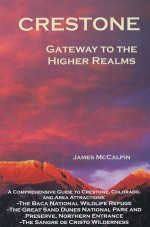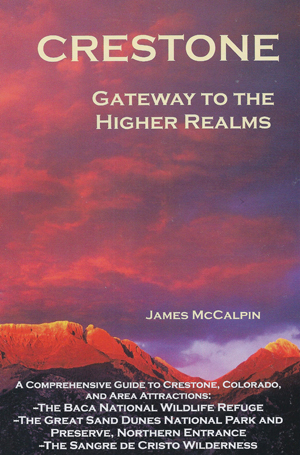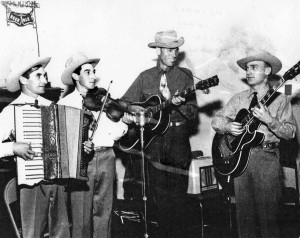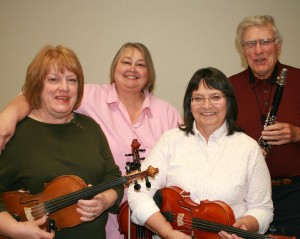Crestone – Gateway to the Higher Realms
By James McCalpin
Crestone Science Center
ISBN 978-0-9835382-0-2
$21.95; 256pp, including appendices and index.
Reviewed by Eduardo Rey Brummel
Remember your grade school teacher’s admonition to never title a paper, “All About —”? That’s the intrinsic trouble with any guidebook: So much information; so few pages. The cover of this one proclaims it to be: “A Comprehensive Guide to Crestone, Colorado, and Area Attractions,” which it truly seems to be.
 You may not find Crestone on your road atlas; and you won’t arrive there by accident, or because you’re passing through. It’s at the end of a miles-long, two lane road, and the nearest (regional) airport, or even bus station, is fifty-some miles away. Town-proper has roughly a hundred citizens, whereas its subdivision is home to ten times that many. However, despite its isolation and miniscule population, Crestone holds a surprisingly hefty place in the national and international collective vocabulary. Because Crestone is a place that many people have lots of ideas and suspicions about, but little information, this guidebook to the area is a good and “it’s about time” thing.
You may not find Crestone on your road atlas; and you won’t arrive there by accident, or because you’re passing through. It’s at the end of a miles-long, two lane road, and the nearest (regional) airport, or even bus station, is fifty-some miles away. Town-proper has roughly a hundred citizens, whereas its subdivision is home to ten times that many. However, despite its isolation and miniscule population, Crestone holds a surprisingly hefty place in the national and international collective vocabulary. Because Crestone is a place that many people have lots of ideas and suspicions about, but little information, this guidebook to the area is a good and “it’s about time” thing.
In the opening section McCalpin does what any good guidebook author should do, giving us the lay of the land, its geography and climate – setting the scene, as it were. He begins his use of diagrams, sidebars, photos (archival and current), and anecdotal tidbits, providing adequate information, without overwhelming. The reader senses they’re in assured, knowledgeable hands; just what you’d look for in a guidebook.
Crestone is the only town on the western edge of the Sangre de Cristo range’s northern end, and McCalpin gives thorough hiking and camping options. Of course, with five mountains, all over fourteen thousand feet and just a day’s hike from the town trailhead, mountain climbing is also covered. However, if technical peak-bagging and the like are what bring you to Crestone, you’ll be better off using a more specialized guide, and McCalpin includes several in his list of references. (An essential part of any guidebook, especially a “comprehensive” one, is knowing when to send readers toward more extensive resources.)
It’s Crestone’s cornucopia of spiritual centers which places it on most mental maps, and McCalpin’s second section is a guide to them. There are so many, it would be easy to bog down with explanation and minutia. Instead, McCalpin holds steady, continuing to offer clear, concise, non-judgmental and useful information.
The book’s third section provides a historic overview of the area. By itself, any of these three sections could stand alone and would be a beneficial guide for its grateful reader. McCalpin binds them all together, along with a handful of helpful appendices, giving us a guidebook that covers all the bases yet is small and handy enough to be actually brought along and used, not left in the car or back home.
If there’s a flaw to this book, it’s the glued-in binding, which isn’t robust enough for the use this guide is destined for. But then, don’t we know better than to go exploring without healthy swatches of duct tape?
Nowadays, Eduardo Rey Brummel sleeps in Salida, while visions of Crestone dance in his head.



